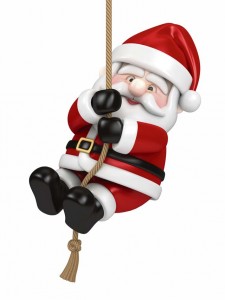The Christmas tradition has many variations around the world. Santa and his “friends” also take on different names, depending on the part of the world. Tomte, Sinterklaas, Ded Moros, Pere Noel, la Befana, Weihnachtsmann and Santa Claus are just a few of the titles given to this jolly holiday man and his friends.
To learn more about the European traditions associated with this famous gift-giver, read on!

In Germany, the “Weihnachtsmann” is responsible for delivering presents on the eve of Dec. 24. Traditionally, he is recognized as the jolly fellow with the red coat and white beard who has a bag full of goodies. But, he is also known for carrying a book where all individual misbehaviors have been noted down.
In the German tradition, on Dec. 6, known as Saint Nicholas Day, Saint Nicholas (the German Santa) fills children’s shoes with sweets and presents and leaves them outside their bedroom doors.
The saint is often joined by Knecht Rubrecht, who is in charge of punishing naughty children. In the Eastern region of the Alps, in Hungary, Slovenia and the Czech Republic, Santa even comes with a group of evil looking men called “Krampusse.” Their names come from the old German word for “claw” and they wear a traditional wooden mask with a devil’s face.
Nations and regions with a strong Catholic influence, such as Italy, Brazil, Austria and Southern Germany, celebrate the coming of the Christ Child on Dec. 24. Introduced by Martin Luther as an alternative to Saint Nicholas, the Christ Child is usually portrayed as a saintly baby with angel wings, who can never be seen when bringing the presents as he always disappears just moments before the children arrive.
Up north, in Iceland, folks know their Santa Clause as “Jolasveinar,” or Yulemen. These 13 Yulemen, who resemble trolls, arrive 13 days prior to Christmas and deliver either reward or punishment into shoes children have placed on their window sills.
Very mischievous, these Yulemen will bring gifts to well-behaved children and leave rotting potatoes for those children whose behavior might not have been too good.
Santa’s Scandinavian colleague Tomte, or Jultomte, lives in the woods, neither flies nor lives at the North Pole, likes to eat “Pepparkakor” (lucky charm cookies), and dances around the Christmas tree. Tomte resembles good ol’ Saint Nick in that he is often found wearing a red cap and delivers presents to deserving children.
The Dutch version of Santa is “Sinterklaas,” who is the closest relative of the North American gift-giver in appearance and humor. However, he comes late in November after arriving by steamboat from Spain. He then parades through the city to greet the children. His helper is a little boy, Black Peter, or “Zwarte Piet.” On Dec. 5, Sinterklaas comes. Children prepare by putting out their shoes near the fireplace (for gifts) and leaving carrots for Sinterklaas’ horse. Black Peter then climbs down the chimney and gives the children either presents or salt, depending on the child’s behavior.
Papa, or Pere Noel, is the French version of Father Christmas. He rides a donkey called “Gui,” which means “mistletoe” in French. On Christmas Eve, children leave out their shoes filled with carrots for the donkey. Pere Noel will then exchange the offerings for presents. Just like in Germany, the French Saint Nicholas visits Dec. 6, bringing children sweets and gifts. His disciplinary counterpart is “Le Pere Fouettard,” the Whipping Father. According to legend, before repenting, he was the marshal of a castle near Wissembourg in Alsace.
Having adapted much of the main stream Santa tradition, Babbo Natale is gaining popularity in Italy. However, the main character of the season is la Befana. On Jan. 6, Italian children expect to see a witch on a broomstick, carrying a bag of presents. Despite her fierce look, legend says she was a kind woman who gave food and shelter to the three Holy Kings on their quest. Though friendly, she punishes children who spy on her as she comes down the fireplace to distribute gifts. Interestingly, she is also said to sweep the floor around the chimney on her way out.
From Russia to Poland and many former Soviet republics, the holiday gift-giver is “Ded Moroz,” or Grandfather Frost. He often wears a silver-blue coat, drives a traditional horse-drawn sled, called Troika, and resides in the Russian town of Veliky Ustyug. According to legends, he is accompanied by his granddaughter “Snegurochka,” the Snow Maiden. Like the French Fouettard, Ded Moroz underwent a major character change. He used to be an evil sorcerer who stole little children and then later became a good guy. Unlike his Western counterparts, Ded Moroz arrives on New Year’s Day to hand over the presents personally at New Year’s parties.
Santa may wear a red or blue robe, ride a sled or a donkey, come at different times during the holiday season, or even be accompanied by a frightening assistant, however, one thing unites them all. No matter if his name is Tome or Pere Noel, Sinterklaas or Weihnachtsmann, children all over the world just can’t wait for him to come. That makes him truly cosmopolitan.







